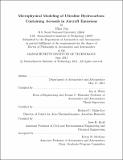Microphysical modeling of ultrane hydrocarbon-containing aerosols in aircraft emissions
Author(s)
Jun, Mina
DownloadFull printable version (6.585Mb)
Other Contributors
Massachusetts Institute of Technology. Dept. of Aeronautics and Astronautics.
Advisor
Ian A. Waitz.
Terms of use
Metadata
Show full item recordAbstract
Combustion engines emit precursors of ne particulate matter (PM) into the atmosphere. Numerous gaseous species, soot particles, and liquid aerosols in the aircraft exhaust are involved in PM formation, and these very ne, nanometer-size particles potentially have signicant impacts on climate, human health, and air quality. In particular, the organic content of the particles is important to determine physical and chemical properties of PM and consequently their potential impacts on the environment. The main objective of this thesis is to understand the role of organic compounds in PM evolution by developing a microphysical model that incorporates organic compounds into the formation mechanism of binary aqueous aerosols. While binary aerosol models with sulfuric acid and water have been widely studied, the understanding of the effect of organics on the formation and growth of aerosols is still insufficient. This work demonstrates important interactions and competitions in the formation of multi-component aerosols with organic compounds, sulfuric acid, and water in aircraft emissions. Hydrocarbon-containing aerosols have been identied as a major component of ground-level aircraft emission, especially at low power operations. This thesis describes selected surrogates of organic species and introduces estimation techniques for their thermophysical properties. The surrogates of organic species include water-insoluble hydrocarbons and water-soluble oxygenated hydrocarbons. Simulation results suggest that certain hydrocarbon compounds play an important role in the formation of aviation aerosol with interactions with both homogeneous sulfuric acidwater aerosols and soot particles in the organic-rich aircraft plume. Hydrocarbons contribute to the growth of existing homogeneous liquid particles, whereas their contribution to aerosol number density is negligible compared to that of sulfuric acid and water, which largely determine the formation of homogeneous aerosols. Also, low volatility hydrocarbons (e.g., benzopyrene, coronene) are observed to be partitioned into soot particles and induce competition with the uptake of water-soluble species, while light water-soluble oxygenated hydrocarbons enhance the uptake of water and sulfuric acid on soot particles.
Description
Thesis (Ph. D.)--Massachusetts Institute of Technology, Dept. of Aeronautics and Astronautics, 2011. This electronic version was submitted by the student author. The certified thesis is available in the Institute Archives and Special Collections. Cataloged from student submitted PDF version of thesis. Includes bibliographical references (p. 109-115).
Date issued
2011Department
Massachusetts Institute of Technology. Department of Aeronautics and AstronauticsPublisher
Massachusetts Institute of Technology
Keywords
Aeronautics and Astronautics.